![]()
![]()
![]()
Use LEFT and RIGHT arrow keys to navigate between flashcards;
Use UP and DOWN arrow keys to flip the card;
H to show hint;
A reads text to speech;
109 Cards in this Set
- Front
- Back
|
Name species, stage: |
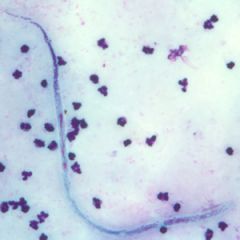
Wucheria bancrofti, mf, thick smear - giemsa stain
|
|
|
What are you looking for with wucherial bancrofti mf?
|
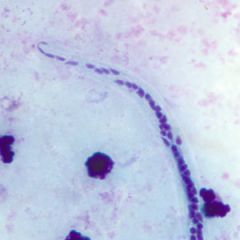
has sheath, extends beyond tail. end of sheath is posterior. Nuclei not densely packed.
- They have a gently curved body, and a tail that is tapered to a point.The nuclear column (the cells that constitute the body of the microfilaria) is loosely packed; the cells can be visualized individually and do not extend to the tip of the tail. |
|
|
What is special with this slide?
|
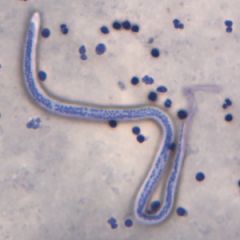
ghost around it, nuclei and nerve ring
|
|
|
1) Name species, stage:
2) what is special about this slide? |
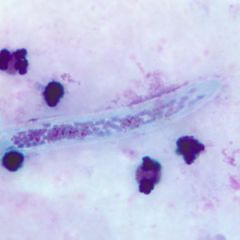
1) Wuchereria bancrofti, mf
2) Imnenkorper - area stains darker "pinker" 1/2 way down |
|
|
1) Name species, stage:
2) Describe the importance of this image |

Wuchereria bancrofti, mf
Anterior blunted round |
|
|
- name species, stage:
- how best to obtain specimens? |
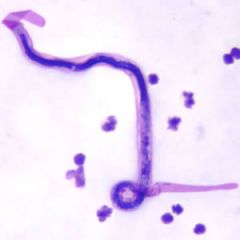
Brugia malayi; mf
- in a thick or thin blood smear, stained with Giemsa. - image is in thick smear |
|
|
- Name species; stage
- How best to obtain specimen |
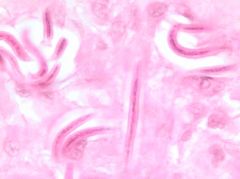
- Onchocercera volvulus; mf
- skin nodule, hematoxylin and eosin (H&E). Image at 1000x mag, oil |
|
|
- name species and stage
- describe diagnositic characteristics |
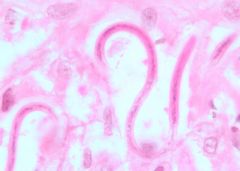
- Onchocerca volvulus; mf
- no sheath, tail tapers to a point and is often sharply bent. The nuclei do not extend to the tip of the tail. |
|
|
- name species and stage
- gross appearance - typical site and appearance in host |
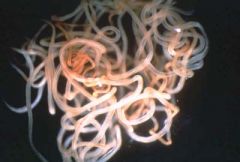
- Onchocerca volvulus; adult
- Cross-section of an adult female O. volvulus, stained with H&E. Note the presence of many microfilariae within the uterus. |
|
|
- name species; stage
|
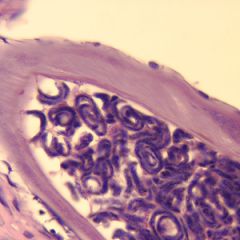
- Ochcocerca volvus; adult - gravid female
- Cross-section of an adult female O. volvulus, stained with H&E. Note the presence of many microfilariae within the uterus. |
|
|
- name species and stage
- describe gross appearance, typical site and appearance in host |
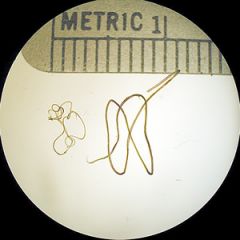
Wuchereria bancrofti; adult
- long, threadllike - females 80-100mm -males 40mm -adults found primarily in lymphatic vessels, less common in blood vessels. |
|
|
- name species and stage
- typical site and appearance in host |
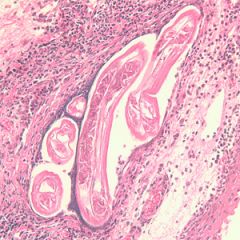
Adults of Brugia spp. typically live in lymphatic vessels, but may be found less-commonly in blood vessels or other regions.
|
|
|
- name species and stage
- describe my tail |
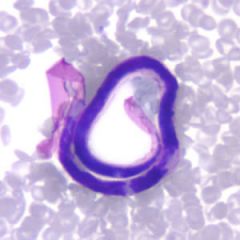
- brugia malayi, mf
- sheathed, dense nuclei, terminal and subterminal nuclei -stains well, densely packed -2 nuclei at top of tail - bulge at tail, 1 subterminal |
|
|
-name species and stage
- typical site and appearance in host |
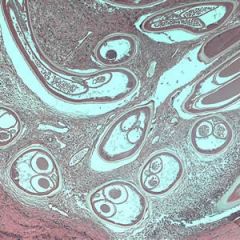
Adult males of Onchocerca volvulus measure 15-45 mm in length; females are 30-50 cm. Adults usually reside in nodules (onchocercomas) in subcutaneous tissue.
|
|
|
-name species and stage
- gross appearance |

long slender shape characteristic of fiilariae
|
|
|
-name species and stage
- how best obtain specimen? |

Microfilaria of L. loa a thick or thin blood smear, stained with Giemsa, but DOES NOT STAIN WELL.
Note the nuclei extending to the tip of the tail to the left of the image. |
|
|
- name species and stage
- name how slide prepared |

Microfilaria of L. loa in a thin blood smear, stained with Giemsa. Sheathed, but does not stain well
|
|
|
- name species and stage
- describe unique characteristic of species |

- Microfilaria of L. loa in a thin blood smear, stained with Giemsa
- tail folds back on itself |
|
|
presbyo-
|

old age
|
|
|
- name species and stage
- diagnositic charactheristics |
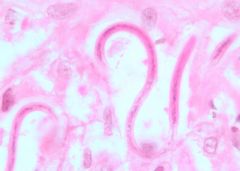
- Microfilariae of O. volvulus from a skin nodule of a patient from Zambia, stained with H&E. Image taken at 1000x oil magnification.
- Not sheathed - Cephalic space LONG - nuclei do NOT go to end - nuclei in body loose - found in skin |
|
|
- name species and stage
- describe gross appearance |

- Adults of L. loa removed from the eye of a patient.
- female adults 60mmx0.5mm, live in tissues |
|
|
- filaria are are of what genus?
- describe body layout |
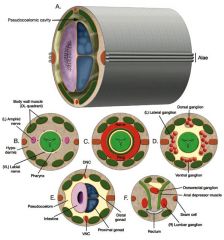
- nematodes
|
|
|
- name species and stage
- gross appearance |
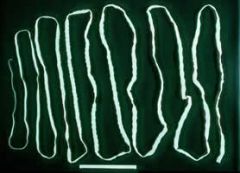
- Taenia saginata adult worms
- Adults of Taenia spp. Adults can reach a length of 2-8 meters, but the scolex is only 1-2 millimeters in diameter |
|
|
- name species and stage
- describe scolex |
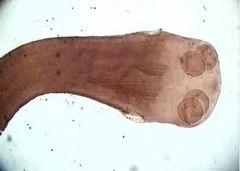
- taenia saginata; adult
- minute -1-2mm diam - 4 prominent suckers - NO rostellum/hooks |
|
|
- describe differences between t. saginata and solium proglottids
|
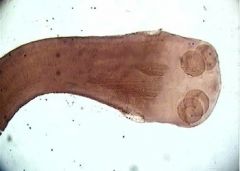
- Taenia saginata:
- 12mmx10-12mm - irregular alternating, lateral genital pores |
|
|
- Taenia egg - describe
|
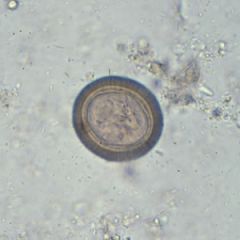
The eggs of Taenia solium and T. saginata are indistinguishable from each other, as well as from other members of the Taeniidae. The eggs measure 30-35 micrometers in diameter and are radially-striated. The internal oncosphere contains six refractile hooks.
|
|
|
- name species and body part
|
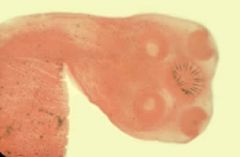
The scolex of T. solium contains four large suckers and a rostellum containing two rows of large and small hooks. There are usually 13 hooks of each size.
|
|
|
- Name species and body part
|
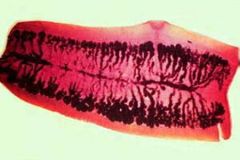
Mature proglottid of T. saginata, stained with carmine. Note the number of primary uterine branches (>12)
- gravid 16-20mmx5-7mm, numerous branches up to 30 - up to 100,000 eggs!!! |
|
|
Taenia saginata egg - describe
|

30-40 um
striated shell yellowish-brown contains HEXACANTH - ONCOSHERE embryo with prominant hooks |
|
|
- describe taenia strobila
|
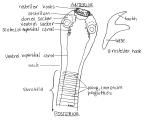
Strobila of cestodes is unique among the Metazoa. As new proglottids are formed from the neck region, progressively posteriad, creating a chain of proglottids - the strobila
|
|
|
Name genus species, stage
- what are the blue arrows - what are the red arrows? |
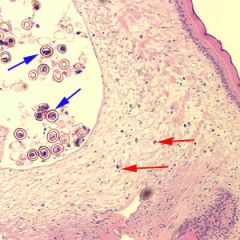
Cross-sections of a proglottid of Taenia sp., stained with H&E. Note the thick outer tegument and the loose parenchyma filling the body. Calcareous corpuscles (red arrows), characteristic of the cestodes, can be seen in the parenchyma. Eggs (blue arrows) can also be seen.
|
|
|
Name genus, species, stage
- Describe diagnositic characteristics |
- Taenia solium, adult tapeworm
- Scolex: Small; it has a rostellum with two rows of hooks, and in addition the scolex bears four prominent suckers. |
|
|
name genius, species, stage
|
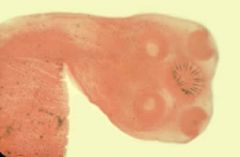
- Taenia solium asa pork tapeworm; adult worm
- Scolex: Small; it has a rostellum with two rows of hooks, and in addition the scolex bears four prominent suckers. |
|
|
name genius, species, stage
- decribe diagnostic characteristics |
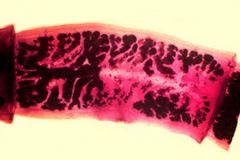
- taenia solium adult worm
- Proglottid: The mature proglottid is roughly square in shape. Easily differentiated from Taenia saginata (the beef tapeworm) by the smaller (7 to 13) number of uterine branches. |
|
|
- name genius, species, stage
- describe pathology |
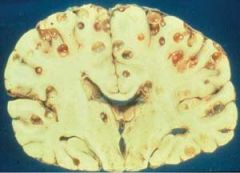
- taenia solium, protoscolex
in brain |
|
|
name genus, species, stage
- describe diagnositic characteristics |
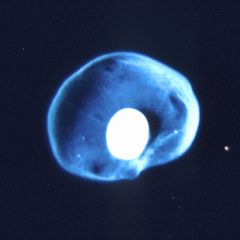
taenia solium cystercecus
- invaginated with rostellum and hooks (not seen in saginata) |
|
|
name genius, species and stage
- describe gross appearance |
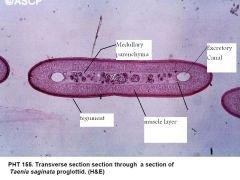
taenia saginata adult worm
|
|
|
name genus, species, stage
|
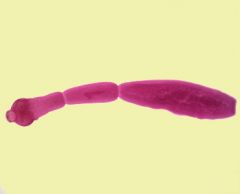
Echinococcus granulosus adult, stained with carmine
|
|
|
name genus, species. stage
- discribe the pathohistology |
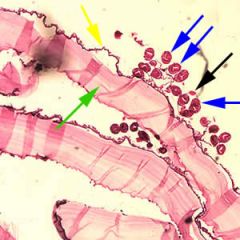
Cross-section of an E. granulosus cyst, stained with H&E. The cyst wall is composed of an acellular laminated external layer (green arrow) and a thin, germinal (nucleated) inner layer (yellow arrow). Note the brood capsule (black arrow) with protoscoleces (blue arrows) inside. Image taken at 40× magnification.
|
|
|
name genus, species, stage
- describe pathohistology |
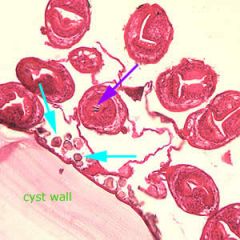
Cross-section of an E. granulosus cyst, stained with H&E. Higher magnification (200×) showing daughter cyst (brood capsule). Note the hooklets (purple arrow) inside one of the protoscoleces and the calcareous corpuscles (light blue arrows) along the germinal layer.
|
|
|
name genus, species, stage
|
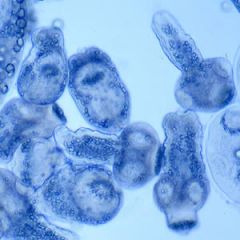
Echinococcus granulosus, Protoscoleces liberated from a hydatid cyst.
|
|
|
name genus, species and stage
|
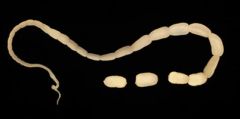
Dipylidium caninum adults measure 10-70 cm long.
- Adult tapeworm of D. caninum. The scolex of the worm is very narrow and the proglottids, as they mature, get larger. |
|
|
name genus, species, stage
- describe diagnostic characteristics |
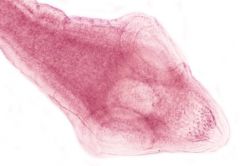
The scolex of Dipylidium caninum is conical-shaped and has four suckers. There is also a retractable rostellum armed with several rings of small spines, used for anchoring into the host’s tissue.
|
|
|
name genus, species and stage
- describe diagnostic characteristics: uterus, ovaries, testes, gential pore, vitellaria... |
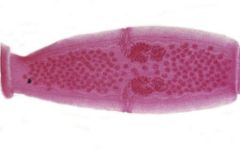
Dipylidium caninum proglottids (average mature size 12 mm × 3 mm) have two genital pores, one in the middle of each lateral margin. Proglottids may be passed singly or in chains, and occasionally may be seen dangling from the anus. They are pumpkin seed-shaped when passed and often resemble rice grains when dried.
D. caninum proglottid. The genital pores are clearly visible in the carmine-stained proglottid. |
|
|
name genus, species, and stage
|
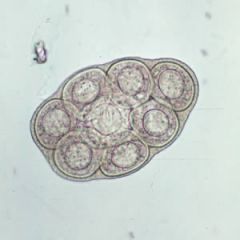
Dipylidium caninum eggs are round to oval (average size 35 to 40 µm; range 31 to 50 µm by 27 to 48 µm) and contain an oncosphere that has 6 hooklets.
|
|
|
name genus, species and stage
- describe diagnositic characteristics |
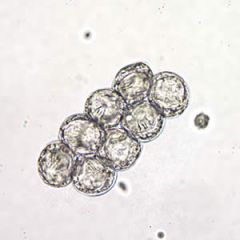
Dipylidium caninum eggs are round to oval (average size 35 to 40 µm; range 31 to 50 µm by 27 to 48 µm) and contain an oncosphere that has 6 hooklets. Proglottids of D. caninum contain characteristic egg packets that are round to ovoid and contain 5 to 15 or more eggs each.
- taken at 400× magnification, hooklets in the some of the eggs are visible. |
|
|
describe dipylidium caninum
s lifecycle |
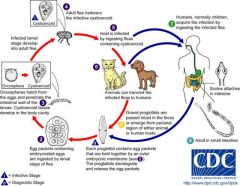
Gravid proglottids are passed intact in the feces or emerge from the perianal region of the host . Subsequently they release typical egg packets . On rare occasions, proglottids rupture and egg packets are seen in stool samples. Following ingestion of an egg by the intermediate host (larval stages of the dog or cat flea Ctenocephalides spp.), an oncosphere is released into the flea's intestine. The oncosphere penetrates the intestinal wall, invades the insect's hemocoel (body cavity), and develops into a cysticercoid larva . The larva develops into an adult, and the adult flea harbours the infective cysticercoid . The vertebrate host becomes infected by ingesting the adult flea containing the cysticercoid . The dog is the principal definitive host for Dipylidium caninum. Other potential hosts include cats, foxes, and humans (mostly children) , . Humans acquire infection by ingesting the cysticercoid contaminated flea. This can be promulgated by close contact between children and their infected pets. In the small intestine of the vertebrate host the cysticercoid develops into the adult tapeworm which reaches maturity about 1 month after infection . The adult tapeworms (measuring up to 60 cm in length and 3 mm in width) reside in the small intestine of the host, where they each attach by their scolex. They produce proglottids (or segments) which have two genital pores (hence the name "double-pored" tapeworm). The proglottids mature, become gravid, detach from the tapeworm, and migrate to the anus or are passed in the stool .
|
|
|
name genus, species, and stage
- how was it preserved? |
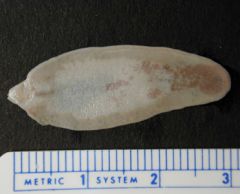
Adults of Fasciola hepatica are large and broadly-flattened, measuring up to 30 mm long and 15 mm wide. The anterior end is cone-shaped, unlike the rounded anterior end of Fasciolopsis buski. Adults reside in the bile ducts of the liver in the definitive host.
-Unstained adult of F. hepatica fixed in formalin |
|
|
name genus, species, stage
- describbe anatomical findings: mouth, ventral sucker, excretory pore |

Adults of Fasciola hepatica are large and broadly-flattened, measuring up to 30 mm long and 15 mm wide. The anterior end is cone-shaped, unlike the rounded anterior end of Fasciolopsis buski.
- stained in carmine |
|
|
cestode body plan
|

MAJOR ORGANS AND EXTERNAL STRUCTURES ALONG THE LENGTH OF A TAPEWORM (CLASS CESTODA).
|
|
|
chinese liver fluke life cycle
|
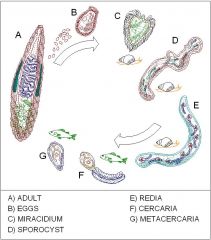
describe the imporant life cylce
|
|
|
name genus species stage
- know anatomical structures |

Trematoda - Clonorchis opisthorichis sinensis adult worm - Anterior end of the chinese liver fluke showing the mouth, intestine and ventral sucker
|
|
|
cestode body plan
|
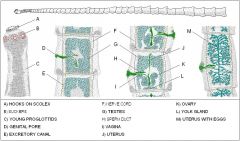
MAJOR ORGANS AND EXTERNAL STRUCTURES ALONG THE LENGTH OF A TAPEWORM (CLASS CESTODA).
|
|
|
name genus species body part and anatomical sections
|

Trematoda - Clonorchis sinensis adult - Posterior end of the chinese liver fluke - testes
|
|
|
name genus species stage and body part
|

Trematoda - Clonorchis sinensis - Uterus of the chinese liver fluke containing mature eggs.
|
|
|
name genus species stage and body part
|

Trematoda - Clonorchis sinensis - Middle section of the chinese liver fluke showing the ovary shell gland and seminal receptacle.
|
|
|
describe fasciola hepatica lifecylce
|
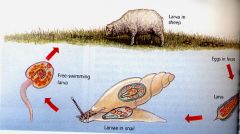
know stages
|
|
|
how big is an adult fasciola hepatica
|
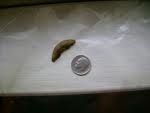
cmpared to a dime
|
|
|
describe a flatworm - trematode body plan
|

know key features
|
|
|
descrive fluke structures
|
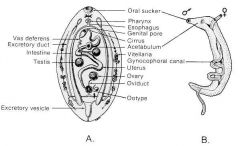
know
|
|
|
name genus species and stage
|
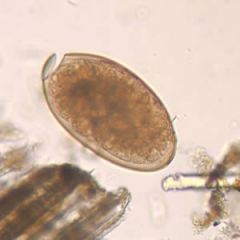
Eggs of Fasciola hepatica are broadly ellipsoidal, operculated and measure 130-150 µm long by 60-90 µm wide. The eggs are unembryonated when passed in feces. The eggs of F. hepatica can be difficult to distinguish from Fasciolopsis spp., although the abopercular end of the former often has a roughened or irregular area.
Eggs of F. hepatica in an unstained wet mount, taken at 400x magnification |
|
|
name genus species and stage
|

Eggs of Fasciola hepatica are broadly ellipsoidal, operculated and measure 130-150 µm long by 60-90 µm wide. The eggs are unembryonated when passed in feces. The eggs of F. hepatica can be difficult to distinguish from Fasciolopsis spp., although the abopercular end of the former often has a roughened or irregular area.
Eggs of F. hepatica in an unstained wet mount, taken at 400x magnification |
|
|
name genus species and stage
|
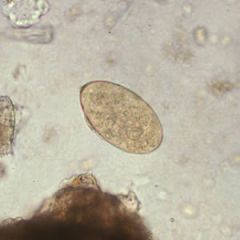
Eggs of Fasciola hepatica are broadly ellipsoidal, operculated and measure 130-150 µm long by 60-90 µm wide. The eggs are unembryonated when passed in feces. The eggs of F. hepatica can be difficult to distinguish from Fasciolopsis spp., although the abopercular end of the former often has a roughened or irregular area.
Egg of F. hepatica in an unstained wet mount. |
|
|
name genus species and stage
|
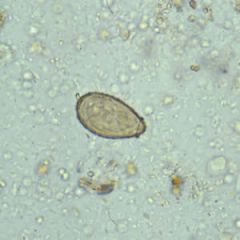
Clonorchis sinensis eggs are small, ranging in size from 27 to 35 µm by 11 to 20 µm. The eggs are oval shaped with a convex operculum, that rests on visible "shoulders," at the smaller end of the egg. At the opposite (larger, abopercular) end, a small knob or hooklike protrusion is often visible. The miracidium is visible inside the egg.
C. sinensis egg. The small knob at the abopercular end is visible in this image. |
|
|
name genus species and stage
|
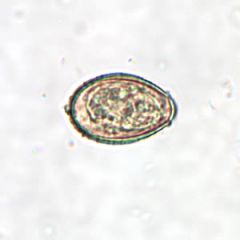
Clonorchis sinensis eggs are small, ranging in size from 27 to 35 µm by 11 to 20 µm. The eggs are oval shaped with a convex operculum, that rests on visible "shoulders," at the smaller end of the egg. At the opposite (larger, abopercular) end, a small knob or hooklike protrusion is often visible. The miracidium is visible inside the egg.
C. sinensis egg. Note the operculum resting on "shoulders;" image taken at 400× magnification |
|
|
name genus species and stage
|
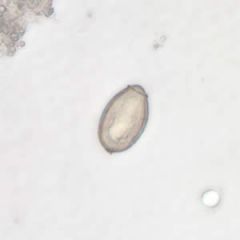
Clonorchis sinensis eggs are small, ranging in size from 27 to 35 µm by 11 to 20 µm. The eggs are oval shaped with a convex operculum, that rests on visible "shoulders," at the smaller end of the egg. At the opposite (larger, abopercular) end, a small knob or hooklike protrusion is often visible. The miracidium is visible inside the egg.
C. sinensis eggs; images taken at 400× magnification |
|
|
name genus species and stage
|

Clonorchis sinensis eggs are small, ranging in size from 27 to 35 µm by 11 to 20 µm. The eggs are oval shaped with a convex operculum, that rests on visible "shoulders," at the smaller end of the egg. At the opposite (larger, abopercular) end, a small knob or hooklike protrusion is often visible. The miracidium is visible inside the egg.
C. sinensis eggs; images taken at 400× magnification |
|
|
name genus species and stage
|
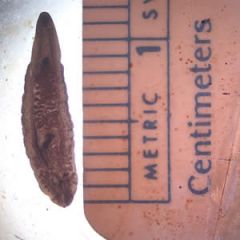
Clonorchis sinensis adults are flattened and measure approximately 10-25 mm long by 3-5 mm wide. Like other flukes, they are hermaphroditic, with a single ovary situated anterior to two branches testes. Adults reside in the biliary passages of the liver of the definitive host.
|
|
|
name genus species and stage
- describe antatomical body parts |
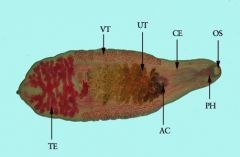
Clonorchis sinensis adults are flattened and measure approximately 10-25 mm long by 3-5 mm wide. Like other flukes, they are hermaphroditic, with a single ovary situated anterior to two branches testes. Adults reside in the biliary passages of the liver of the definitive host.
Adult of C. sinensis stained with carmine. Clearly visible in this image are the oral sucker (OS), pharynx (PH), ceca (CE), acetabulum, or ventral sucker (AC), uterus (UT), vitellaria (VT) and testes (TE). |
|
|
describe c.sensis life cycle
|
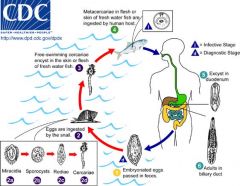
Embryonated eggs are discharged in the biliary ducts and in the stool . Eggs are ingested by a suitable snail intermediate host . Each egg releases a miracidia , which go through several developmental stages (sporocysts , rediae , and cercariae ). The cercariae are released from the snail and after a short period of free-swimming time in water, they come in contact and penetrate the flesh of freshwater fish, where they encyst as metacercariae . Infection of humans occurs by ingestion of undercooked, salted, pickled, or smoked freshwater fish . After ingestion, the metacercariae excyst in the duodenum and ascend the biliary tract through the ampulla of Vater . Maturation takes approximately 1 month. The adult flukes (measuring 10 to 25 mm by 3 to 5 mm) reside in small and medium sized biliary ducts. In addition to humans, carnivorous animals can serve as reservoir hosts.
|
|
|
name genus species and life cycle
|
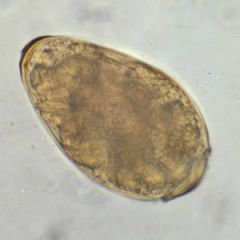
Paragonimus westermani eggs range from 80-120 µm long by 45-70 µm wide. They are yellow-brown, ovoid or elongate, with a thick shell, and often asymmetrical with one end slightly flattened. At the large end, the operculum is clearly visible. The opposite (abopercular) end is thickened. The eggs are unembryonated when passed in sputum or feces.
Eggs of P. westermani in unstained wet mounts. |
|
|
name genus species and stage
|
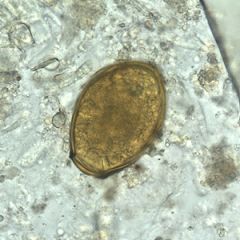
Paragonimus westermani eggs range from 80-120 µm long by 45-70 µm wide. They are yellow-brown, ovoid or elongate, with a thick shell, and often asymmetrical with one end slightly flattened. At the large end, the operculum is clearly visible. The opposite (abopercular) end is thickened. The eggs are unembryonated when passed in sputum or feces.
Eggs of P. westermani in unstained wet mounts. |
|
|
name genus species and stage
Where would you most likely see this species? |
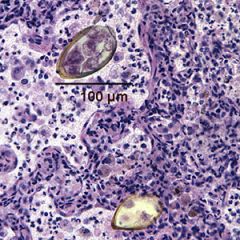
Paragonimus spp. eggs range from 50-125 µm by 35-70 µm . They are yellow-brown, ovoid or elongate, with a thick shell, and often asymmetrical with one end slightly flattened. At the large end, the operculum is clearly visible. The opposite (abopercular) end is thickened. The eggs are unembryonated when passed in sputum or feces.
Eggs of Paragonimus sp. taken from a lung biopsy stained with hematoxylin and eosin (H&E). These eggs measured 80-90 µm by 40-45 µm. The species was not identified in this case. |
|
|
name genus species and stage, taken from a lung
|
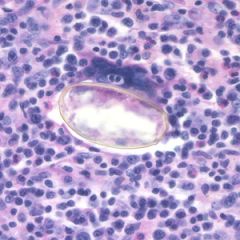
Paragonimus spp. eggs range from 50-125 µm by 35-70 µm . They are yellow-brown, ovoid or elongate, with a thick shell, and often asymmetrical with one end slightly flattened. At the large end, the operculum is clearly visible. The opposite (abopercular) end is thickened. The eggs are unembryonated when passed in sputum or feces.
Eggs of Paragonimus sp. taken from a lung biopsy stained with hematoxylin and eosin (H&E). These eggs measured 80-90 µm by 40-45 µm. The species was not identified in this case. |
|
|
name genus species and stage
|

Adults of Paragonimus spp. are large, robust, ovoid flukes. They are hermaphroditic, with a lobed ovary located anterior to two branching testes. Like all members of the Trematoda, they possess oral and ventral suckers.
|
|
|
name genus species and stage
|
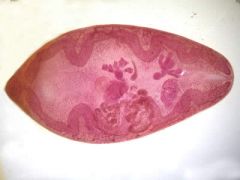
Adults of Paragonimus spp. are large, robust, ovoid flukes. They are hermaphroditic, with a lobed ovary located anterior to two branching testes. Like all members of the Trematoda, they possess oral and ventral suckers.
|
|
|
name genus species, stage and body parg
|
Adults of Paragonimus spp. are large, robust, ovoid flukes. They are hermaphroditic, with a lobed ovary located anterior to two branching testes. Like all members of the Trematoda, they possess oral and ventral suckers.
Adult of Paragonimus sp., taken from a lung biopsy specimen stained with hematoxylin and eosin (H&E). Note the presence of the oral sucker. |
|
|
name genus species, stage and body part
|

Adult of Paragonimus sp., taken from a lung biopsy specimen stained with hematoxylin and eosin (H&E). a close-up of the cuticle
|
|
|
describe the life cycle of paragonimus westermani
|
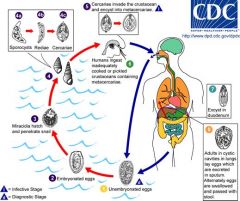
The eggs are excreted unembryonated in the sputum, or alternately they are swallowed and passed with stool . In the external environment, the eggs become embryonated , and miracidia hatch and seek the first intermediate host, a snail, and penetrate its soft tissues . Miracidia go through several developmental stages inside the snail : sporocysts , rediae , with the latter giving rise to many cercariae , which emerge from the snail. The cercariae invade the second intermediate host, a crustacean such as a crab or crayfish, where they encyst and become metacercariae. This is the infective stage for the mammalian host . Human infection with P. westermani occurs by eating inadequately cooked or pickled crab or crayfish that harbor metacercariae of the parasite . The metacercariae excyst in the duodenum , penetrate through the intestinal wall into the peritoneal cavity, then through the abdominal wall and diaphragm into the lungs, where they become encapsulated and develop into adults (7.5 to 12 mm by 4 to 6 mm). The worms can also reach other organs and tissues, such as the brain and striated muscles, respectively. However, when this takes place completion of the life cycles is not achieved, because the eggs laid cannot exit these sites. Time from infection to oviposition is 65 to 90 days.
Infections may persist for 20 years in humans. Animals such as pigs, dogs, and a variety of feline species can also harbor P. westermani. |
|
|
name genus, species and stage
- describe body layout |
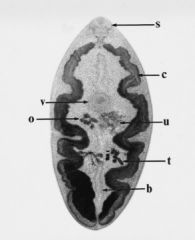
Fig. 22.4 Adult P. westermani, ventral aspect. The fluke's reproductive and somatic structures are labeled as follows: s oral sucker; c cecum; u uterus; t testis; b excretory bladder; v ventral sucker; o ovary. x9; AFIP 76-5953 (From D.H. Connor and F.W. Chandler, eds. Pathology of Infectious Diseases. Appelton and lange, Stamford Conn., 1997. Original photography courtesy of Mr. Harold Langben, Walter Reed Army Institute of Research).
|
|
|
name genus, species, stage it is in lung tissue
|

Paragonimus westermani. Two adult flukes lie within a lung cavity surrounded by a fibrous wall.
|
|
|
name genus species, stage and histopathology
(trick there are two) |
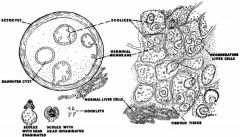
If the larva is not destroyed, it develops into a tiny cyst containing a small amount of clear fluid (Fig. 3.5). This mainly hollow cyst grows steadily over a period of years, at times reaching enormous proportions before it becomes clinically evident (Figs. 3.6, 3.7, 3.8). The average rate of growth varies from 1 to 5 cm a year, being partly determined by the pressure resistance of its anatomical location. Thus, its rate of growth is more rapid in the lungs than in the liver, spleen, or other solid organs, and slowest in bones. If the cyst has room to develop easily, as happens in the liver, lungs or peritoneum, it almost always grows as the classic unilocular cyst. It can remain latent for a long period, up to 53 years having been reported.
Fig. 3.5 Larvae of E. granulosus and E. multilocularis. In the E. granulosus larva (left), note the outer ectocyst, the acellular hyaline cuticle, the germinal membrane lining the endocyst and, within the endocyst itself, the brood capsules with scolices and daughter cysts: note also the scolices with their heads evaginated or invaginated (lower left). By comparison, the E. multilocularis larva (right) buds outwards exogenously into the host tissue without the formation of an enveloping capsule. Note the numerous brood capsules containing invaginated scolices. |
|
|
name genus species, stage and histopathology
|

Microscopic pathology of a segment of an intact E. granulosus cyst from inside to outside: (1) single germinal cell layer with protoscolex; (2) laminated membrane supporting the germinal layer; both 1 and 2 = the parasitic cyst (endocyst); (3) pericyst (adventitial layer) produced by the host to confine the parasite, consisting of collagen and fibroblast tissue containing blood vessels through which the parasite receives nutrients by diffusion. (Courtesy of Dr. von Sinner.)
|
|
|
name genus species, stage, and histopathology
|
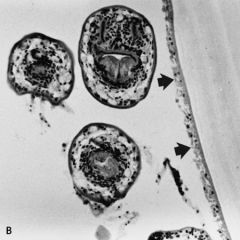
echinococcus granulosis: Microscopic section of endocyst showing laminated membrane (right) lined on its inner surface by the nucleated germinal layer (arrows) which produces brood capsules and scolices. One scolex is intact but the others have been sectioned. Linear fragments of a disintegrated brood capsule from which scolices were released are seen inferiorly (Hematoxylin & eosin, X 250). (Courtesy of Dr. Lewall.)
|
|
|
name genus species, stage and histopathology
|
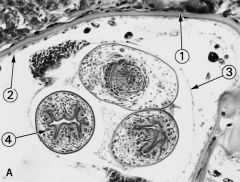
Echinococcus granulosis.
Microscopic section of a hydatid cyst showing brood capsules and scolices. This cross-section of a liver hydatid clearly reveals the acellular, hyaline, outer layer of the cyst (arrow 1) and the delicate inner layer or germinal membrane (arrow 2). A large brood capsule (arrow 3) arises from the germinal membrane as a vesicle one cell layer thick. Invaginated scolices (arrow 4) arise as buds from the inner surface of the brood capsule. AFIP 55-4985. |
|
|
name genus, species, stage and histopatholgoy
|
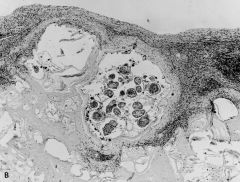
Echinococcus granulsosis
Hydatid cyst in the lung of a dog showing the thick pericyst, the thin germinal membrane of the endocyst, and several brood capsules containing multiple scolices. AFIP 56-11365. |
|
|
name genus species, stage and histopathology
|
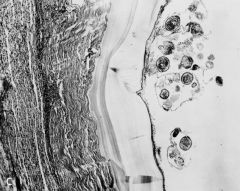
echincococcus granulosis
A hydatid cyst of the liver showing the thick, acellular, adventitial layer, the thin germinal layer, and brood capsules with scolices. (Hematoxylin and eosin, X 72). AFIP 65-2462. |
|
|
name genus species and stage and histopath
|
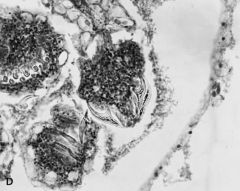
echinococcus granulosis
|
|
|
name genus species, stage and histopath
|
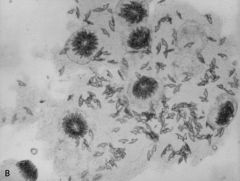
echinococcus granulosis
Hydatid cysts contain "sand" or sediment with multiple scolices and hooklets. (B) The sediment from a hydatid cyst containing numerous invaginated scolices with their hooklets, as well as free-floating, detached hooklets. |
|
|
name genus species, stage
What is different between these two?? |
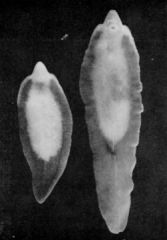
Fasciola hepatica (left) and F. gigantica adult worms (right).
|
|
|
name genus species and stage
|
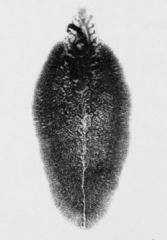
Fasciola hepatica, adult fluke. Whole mount.
|
|
|
name genus, species and sex
|

Adults of Schistosoma mansoni. Unlike the flukes, adult schistosomes have the sexes separate, with the female residing in a gynecophoral canal within the male. Male worms are robust, tuberculate and measure 6-12 mm in length. Females are longer (7-17 mm in length) and slender. Adult S. mansoni reside in the venous plexuses of the colon and lower ileum and in the portal system of the liver of their host.
Adults of S. mansoni. The thin female resides in the gynecophoral canal of the thicker male. |
|
|
name genus species, stage and diagnositic characteristics
|
Adults of S. mansoni. The thin female resides in the gynecophoral canal of the thicker male. Note the tuberculate exterior of the male
|
|
|
name genus species and stage
- id diagnositic characterisitcs |

Adults of S. mansoni. The thin female resides in the gynecophoral canal of the thicker male. Note the tuberculate exterior of the male
|
|
|
name genus species, stage
|
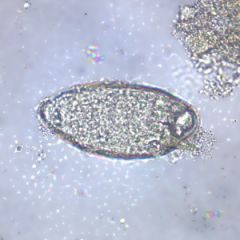
Schistosoma mansoni eggs are large (114 to 180 µm long by 45-70 µm wide) and have a characteristic shape, with a prominent lateral spine near the posterior end. The anterior end is tapered and slightly curved. When the eggs are excreted in stool, they contain a mature miracidium.
|
|
|
name genus, species and stage
|
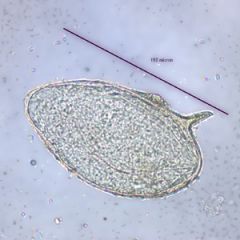
Schistosoma mansoni eggs are large (114 to 180 µm long by 45-70 µm wide) and have a characteristic shape, with a prominent lateral spine near the posterior end. The anterior end is tapered and slightly curved. When the eggs are excreted in stool, they contain a mature miracidium.
Eggs of S. mansoni in unstained wet mounts. |
|
|
name genus species and stage
|
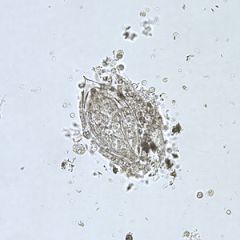
The eggs of Schistosoma haematobium are large (110-170 µm long by 40-70 µm wide) and bear a conspicuous terminal spine. Eggs contain a mature miracidium when shed in urine.
Eggs of S. haematobium in wet mounts of urine concentrates, showing the characteristic terminal spine. |
|
|
name genus species, stage
|

The eggs of Schistosoma haematobium are large (110-170 µm long by 40-70 µm wide) and bear a conspicuous terminal spine. Eggs contain a mature miracidium when shed in urine.
Eggs of S. haematobium in wet mounts of urine concentrates, showing the characteristic terminal spine |
|
|
name genus species, stage and diagnositic criteria
|

The eggs of Schistosoma japonicum are large and more rounded than other species, measuring 70-100 µm long by 55-64 µm wide. The spine on S. japonicum eggs is smaller and less conspicuous than other species. Eggs are shed in stool.
A B A, B Eggs of S. japonicum in unstained wet mounts. Note the small, inconspicuous spines (red arrows). |
|
|
name genus, species, stage and diagnositic criteria
|
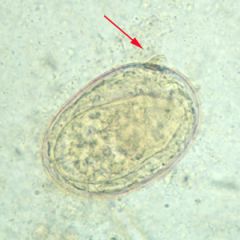
The eggs of Schistosoma japonicum are large and more rounded than other species, measuring 70-100 µm long by 55-64 µm wide. The spine on S. japonicum eggs is smaller and less conspicuous than other species. Eggs are shed in stool.
A B A, B Eggs of S. japonicum in unstained wet mounts. Note the small, inconspicuous spines (red arrows). |
|
|
name genus species, stage
|
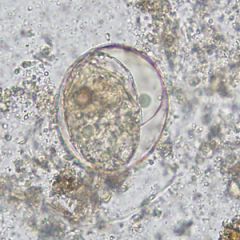
The eggs of Schistosoma japonicum are large and more rounded than other species, measuring 70-100 µm long by 55-64 µm wide. The spine on S. japonicum eggs is smaller and less conspicuous than other species. Eggs are shed in stool.
Eggs of S. japonicum in an unstained wet mount of stool. The spine is not visible in either of these specimens. |
|
|
name genus species stage
|
Eggs of S. japonicum in an unstained wet mount of stool. The spine is not visible in either of these specimens.
|
|
|
name genus species and state
|
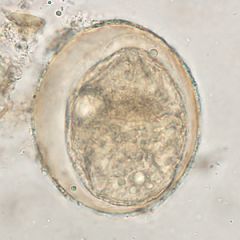
Eggs of S. japonicum in an unstained wet mount of stool. The spine is not visible in either of these specimens.
|
|
|
name genus species and stage
|
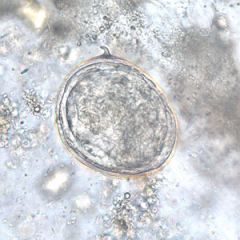
The eggs of Schistosoma japonicum are large and more rounded than other species, measuring 70-100 µm long by 55-64 µm wide. The spine on S. japonicum eggs is smaller and less conspicuous than other species. Eggs are shed in stool.
Eggs of S. japonicum in an unstained wet mount of stool. |
|
|
name genus species and stage
|
Eggs of Shcistosoma mansoni in liver tissue, stained with H&E.
|
|
|
name genus species and stage
|
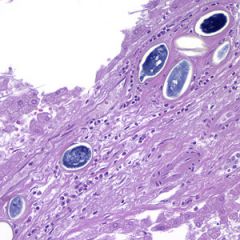
Eggs of S. japonicum from tissue, stained with H&E. Figure C was taken at 200x magnification;
|
|
|
name genus species and stage
|
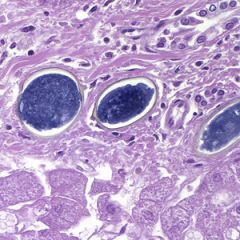
Eggs of S. japonicum from tissue, stained with H&E. Figure D at 400x magnification.
|
|
|
name genus species and stage
|
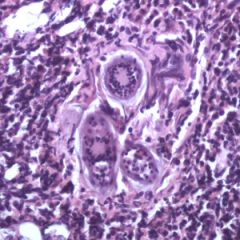
Eggs of Schistosoma haematobium in a urinary bladder biopsy specimen, stained with H&E.
|
|
|
name genus species and stage
|
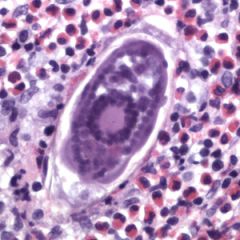
Eggs of Schistosoma haematobium in a urinary bladder biopsy specimen, stained with H&E.
|

